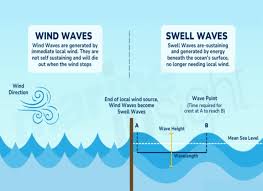Swell waves:

The Indian National Centre for Ocean Information Services (INCOIS) has issued extensive advisories for swell waves for Andaman and Nicobar and Lakshadweep as well as parts of coastal areas in Andhra, Goa, Gujarat, Kerala, Maharashtra, Odisha, Tamil Nadu, West Bengal, Daman and Diu, and Puducherry.
- Swell waves are also called Kallakkadal waves in India, which is a colloquial term used by Kerala fishermen to denote sudden waves that cause flash floods.
- INCOIS Hyderabad launched its swell surge forecast system in February 2020 to provide warnings for coastal populations in case of anticipated swell waves.
- Swell waves are long-wavelength ocean waves that travel away from their places of origin. They are usually created by windstorms or other weather systems. Sea waves otherwise are usually generated due to local winds.
- Windstorms and other powerful air current systems transfer energy from the air to water, making swell waves more powerful. Because of their high energy, swell waves are able to travel large distances and strike shores with considerably high power.
- According to INCOIS, swell waves organise themselves into groups of similar heights and periods, and then travel long distances without much change. Wave period is the time one wavelength takes to pass a specific point.
- Longer wavelengths, therefore, result in longer wave periods, and these characteristics are associated with faster and more powerful waves.
- A wave is essentially a transfer of energy from one point to another. Shorter waves dissipate more energy due to frequent movement, which is why they also lose energy quickly. Longer wavelengths are more powerful, and this is also why swells continue to persist days after they are formed.
- Kallakkadal waves inundate large areas of land.
- These waves are also sometimes confused with tsunami waves given their stealthy nature, but both are different.
- Kallakkadal waves are caused due to weather phenomenon, while tsunamis are mostly caused due to earthquakes or tectonic activity.




